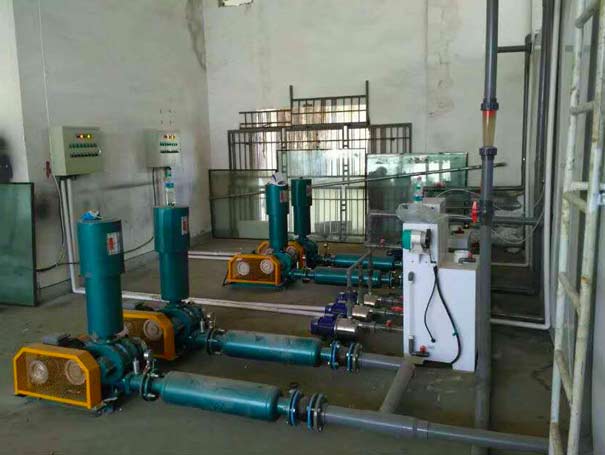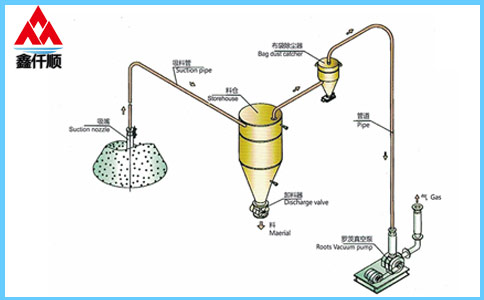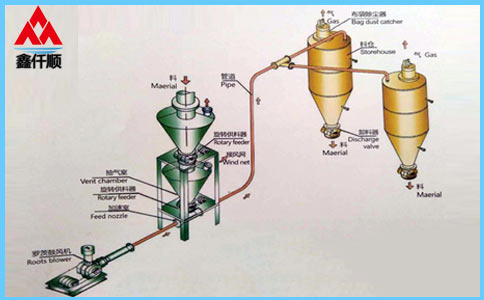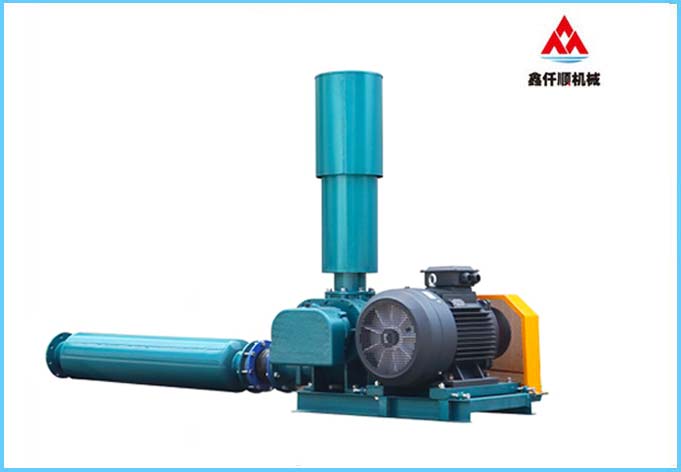Many people have doubts about whether Roots blower can operate under load. Today, I will take you to understand and help you solve this problem.
Roots blower is a volume rotary blower. The compressor keeps the two rotors engaged by the synchronous gear at the rotor shaft end. Each concave curved surface on the rotor forms a working volume with the inner wall of the cylinder. During the rotation of the rotor, the gas is taken away from the suction port. When the rotor moves to the exhaust port near which it is connected with the exhaust port, the pressure in the working volume suddenly rises due to the backflow of high pressure gas, and then the gas is transported to the exhaust channel. The two rotors do not contact each other, and they are sealed by a tightly controlled gap, so the discharged gas is not polluted by lubricating oil. Roots blower is a positive displacement fan, with impeller end face, fan front and rear end covers. The principle is a rotary compressor that compresses and transports gas by using two blade rotors to make opposite movements in the cylinder. The blower is simple in structure and easy to manufacture. It is widely used in aquaculture oxygenation, sewage treatment aeration, cement transmission, and more suitable for gas transmission and pressurization systems in low pressure occasions, and can also be used as a vacuum pump. The casing and wallboard have good rigidity, and the external surface and bottom of the engine body have reasonably arranged reinforced casing and wallboard with natural air cooling and water cooling structures. Considering that the exhaust temperature of the blower varies with the suction gas temperature and exhaust pressure of the blower.
Practice has proved that when the temperature of the suction air is 40 ℃ and the exhaust pressure is 60kPa, the exhaust temperature can reach about 100C. Therefore, when the exhaust pressure is greater than 50kPa, the fan adopts the cooling method with water interlayer to cool the body and medium. When the exhaust pressure is less than 50kPa, the engine body adopts natural cooling. The wallboard of Roots blower is on both sides of the casing. The wallboard is equipped with seals and bearing seats as the support of the fan, and is combined with the casing to form a closed cylinder. The wall panels of vertical blowers are of integral structure, the bearing seat and seal are in the same integral structure, and the wall panels of horizontal blowers are of combined structure, that is, the wall panel is divided into upper and lower parts, the lower part is one piece, and the upper part is divided into two pieces, the seal and bearing seat are separated, and the separated part is exposed. For the transportation of corrosive media, if the previous two structures both adopt the same sealing structure, when the sealing performance is poor, the corrosive media will be discharged to the outside instead of directly entering the bearing after leakage. Therefore, the bearing of the latter structure suffers from corrosion damage slowly and has a longer service life compared with the bearing, while the former is damaged quickly and has a shorter service life due to corrosive media entering the bearing directly.

When replacing the filter cotton of Roots blower, you can choose to purchase it from the original factory or from the dealer. In order to ensure the consistent filtering accuracy, it is recommended that customers choose from the manufacturer. As long as the model of the equipment is reported to the manufacturer, the manufacturer will send us a filter element with corresponding accuracy. The negative pressure dilute phase pneumatic conveying system uses Roots blower or vacuum pump as the air source equipment, The components of the reclaiming device are usually a suction gun and a volumetric feeder. The air source equipment is installed at the end of the system. When the fan runs, the whole system forms a negative pressure, and the pressure difference air inside and outside the pipe is sucked into the feeding pipe. At the same time, the material and part of the air are sucked into the suction nozzle at the same time and transported to the vacuum feeder. In the vacuum feeder, the material and air are separated, The separated materials are discharged from the bottom of the vacuum feeder, while the fine powder particles that are not separated enter the dust remover with the airflow for purification, and the purified air is discharged into the atmosphere through the dust remover The advantage of negative pressure dilute phase pneumatic conveying is that it is easy to take materials, and it is suitable for the occasions requiring no dust; It is suitable for low, deep, narrow reclaiming points and centralized feeding from several places to one place; Since the air source is located at the end of the system, lubricating oil or water will not mix with the conveyed materials; Since the pressure in the conveying pipe system is lower than the atmospheric pressure, the conveyed materials will not leak even if there is wear and clearance; Since the pressure in the conveying system is lower than the atmospheric pressure, the moisture is easy to evaporate, so it is easier to transport materials with more moisture than pressure conveying
The wallboard is on both sides of the casing. The wallboard is equipped with seals and bearing seats. As the support of the fan, it is combined with the casing to form a closed cylinder. The wallboard of the vertical blower adopts an integral structure. The bearing seats and seals are in the same integral structure. The wallboard of the horizontal blower adopts a combined structure, that is, the wallboard is divided into upper and lower parts, The lower part is the same sealing structure for one side and two structures. When the sealing performance is poor, the corrosive medium will be discharged outside rather than directly entering the bearing after leakage. Therefore, the latter type of sealed bearing is slowly damaged due to corrosion and has a longer service life compared with the bearing, while the former is slowly damaged and has a shorter service life due to corrosive media directly entering the bearing. The gear and shaft of Roots blower adopt transition fit with high precision, and the key used to fix the gear adopts special tolerance fit to prevent the gear key from loosening, so that the gear can be tightly fixed on the shaft, so as to avoid that once the gear is loose, the gear backlash will increase, which will cause collision between the two impellers.
Generally, it is very normal if the load is rated, and it is completely abnormal if the load is overloaded. For example, in the normal operation of Roots blower, the inlet and outlet valves cannot be completely closed, let alone the overload operation, which is even more inaccurate. Some factories use blowers. If the blowers are used, they should not be stopped suddenly at full load. They should be stopped after unloading step by step to avoid machine damage. Due to its characteristics, the gas at the exhaust port is not allowed to return to the air inlet for a long time, which affects the machine oil. In this case, cooling measures should be taken.
I believe that after reading the above, you should also have a certain understanding of whether Roots blower can operate under load. I hope it will help you in the future.
Text term label: Roots blower
Link to this article: //wuhanzhcs.com/html/news/n02/594.html










